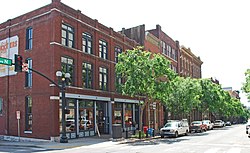United States historic place
| Second Avenue Commercial District | |
| U.S. National Register of Historic Places | |
 A block of the district in 2010. A block of the district in 2010. | |
| Location | Nashville, Tennessee, US |
|---|---|
| Coordinates | 36°09′50″N 86°46′35″W / 36.16389°N 86.77639°W / 36.16389; -86.77639 |
| NRHP reference No. | 72001237 |
| Added to NRHP | February 23, 1972 |
The Second Avenue Commercial District is a historic district in Nashville, Tennessee, consisting of Second Avenue North between Brandon Street and Broadway. It was listed on the National Register of Historic Places on February 2, 1972.
History
Buildings in the district, located along Second Avenue, were constructed in the 1870s and 1880s. Second Avenue was originally named Market Street, as it connected industrial and commercial areas of Nashville. Its name was changed to Second Avenue in 1903.
The Second Avenue Historic Preservation Overlay District is a coextensive district created by the local government. It was established in March 1997 by the Metropolitan Historic Zoning Commission (MHZC), which is part of the Metropolitan Government of Nashville and Davidson County. Exterior alterations in the overlay district require approval from the MHZC.
Incidents
A fire in 1985 damaged three buildings in the districts, resulting in their demolition; the other buildings remain intact.
A bombing in 2020, which took place at the 160 block of Second Avenue North, damaged many buildings in the area, which is primarily a commercial district with shops, offices, restaurants, and honky-tonks.
Architecture
Buildings in the district are noted for their cornices and brickwork. Primarily three and four stories tall, the buildings are mostly in the Victorian Italianate style (with a few being in the Commercial Style) and many overlook the Cumberland River.
One 1987 guidebook describes the district as "ne of the most outstanding collections of cast-iron and masonry storefronts in the U.S."
See also
References
- ^ "Second Avenue Commercial District". National Register of Historic Places. Retrieved December 26, 2020.
- ^ The National Register of Historic Places. National Park Service. 1974. pp. 501.
- West, Carroll Van (1995). Tennessee's Historic Landscapes: A Traveler's Guide. University of Tennessee Press. p. 89. ISBN 978-0-87049-881-7.
- ^ Second Avenue HP Zoning Overlay Design Guidelines, Metropolitan Historic Zoning Commission, Metropolitan Government of Nashville and Davidson County (2019).
- Ward, Getahn (January 19, 2016). "Condos, retail space planned at historic downtown site". The Tennessean. Retrieved December 26, 2020.
- Medina, Daniella (December 26, 2020). "Nashville explosion: Map of area impacted by bomb blast and a look at nearby businesses". The Tennessean. Retrieved December 26, 2020.
- Hawkins, Derek; Kranish, Michael; Firozi, Paulina (December 25, 2020). "RV that exploded in Nashville broadcast a message warning of imminent blast, police say". The Washington Post. Retrieved December 26, 2020.
- Richardson, Ralph W (1987). Historic Districts of America: The South. Heritage Books. p. 187. ISBN 1-55613-088-0. OCLC 18559953.
External links
- Photographs of Second Avenue, compiled as part of the Historic American Buildings Survey